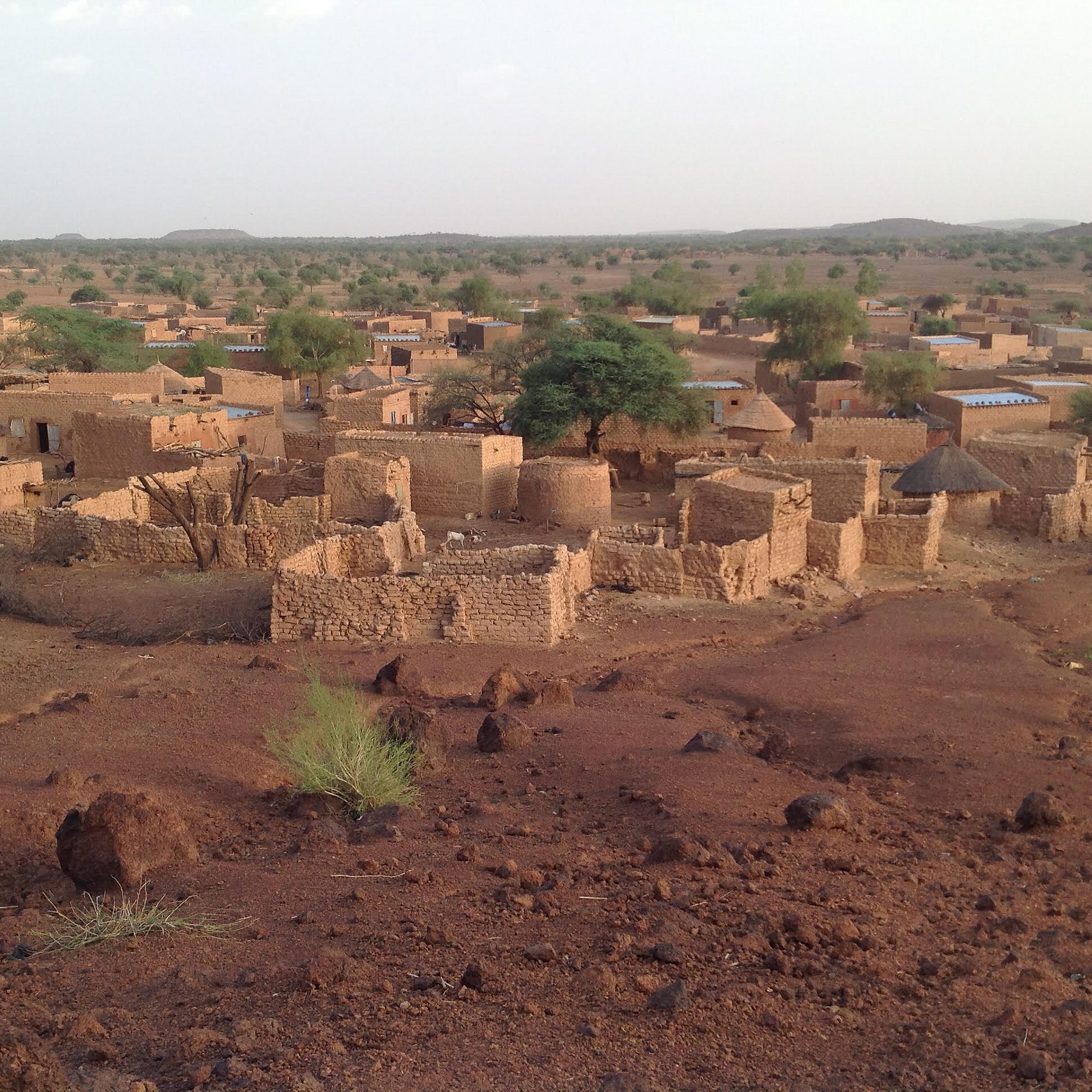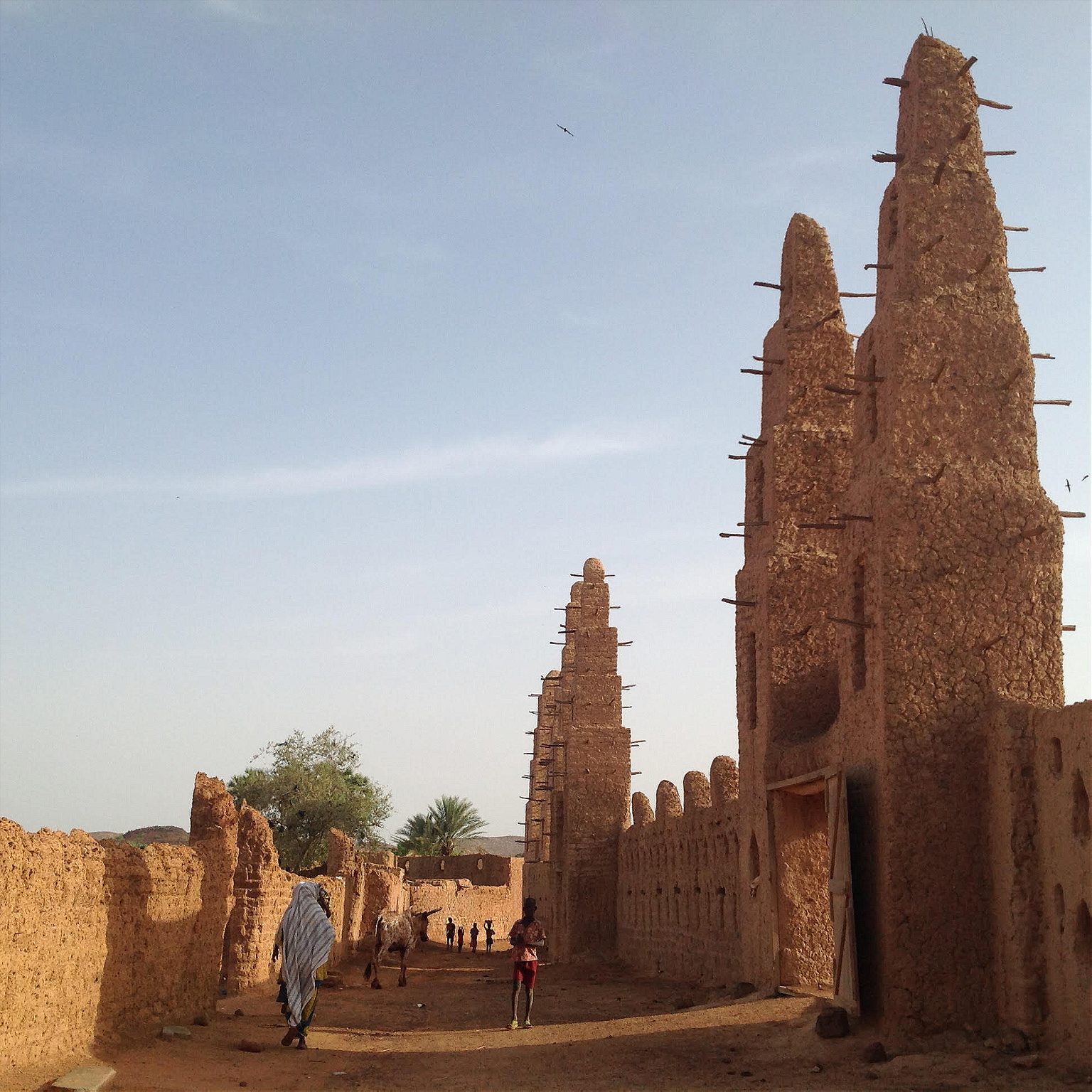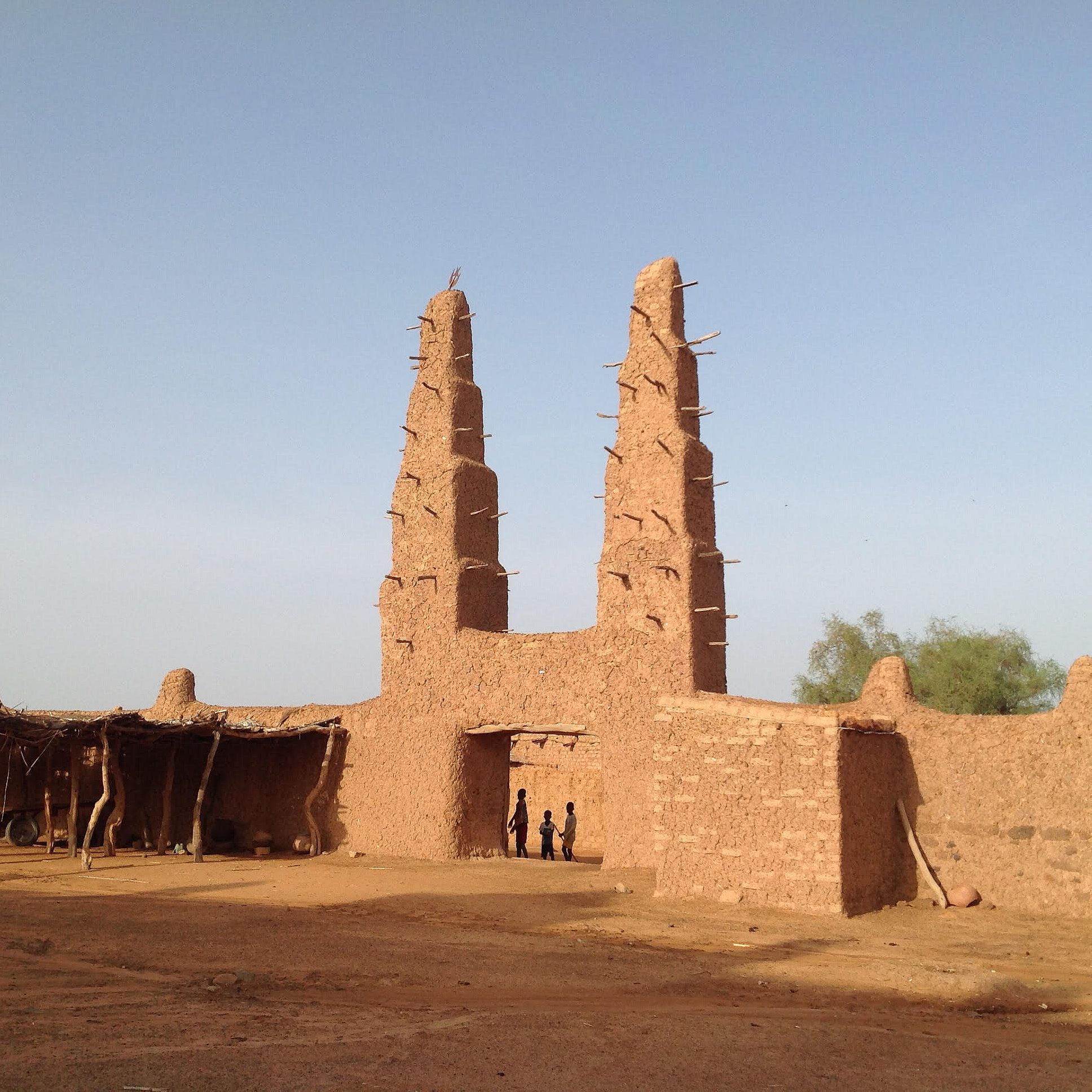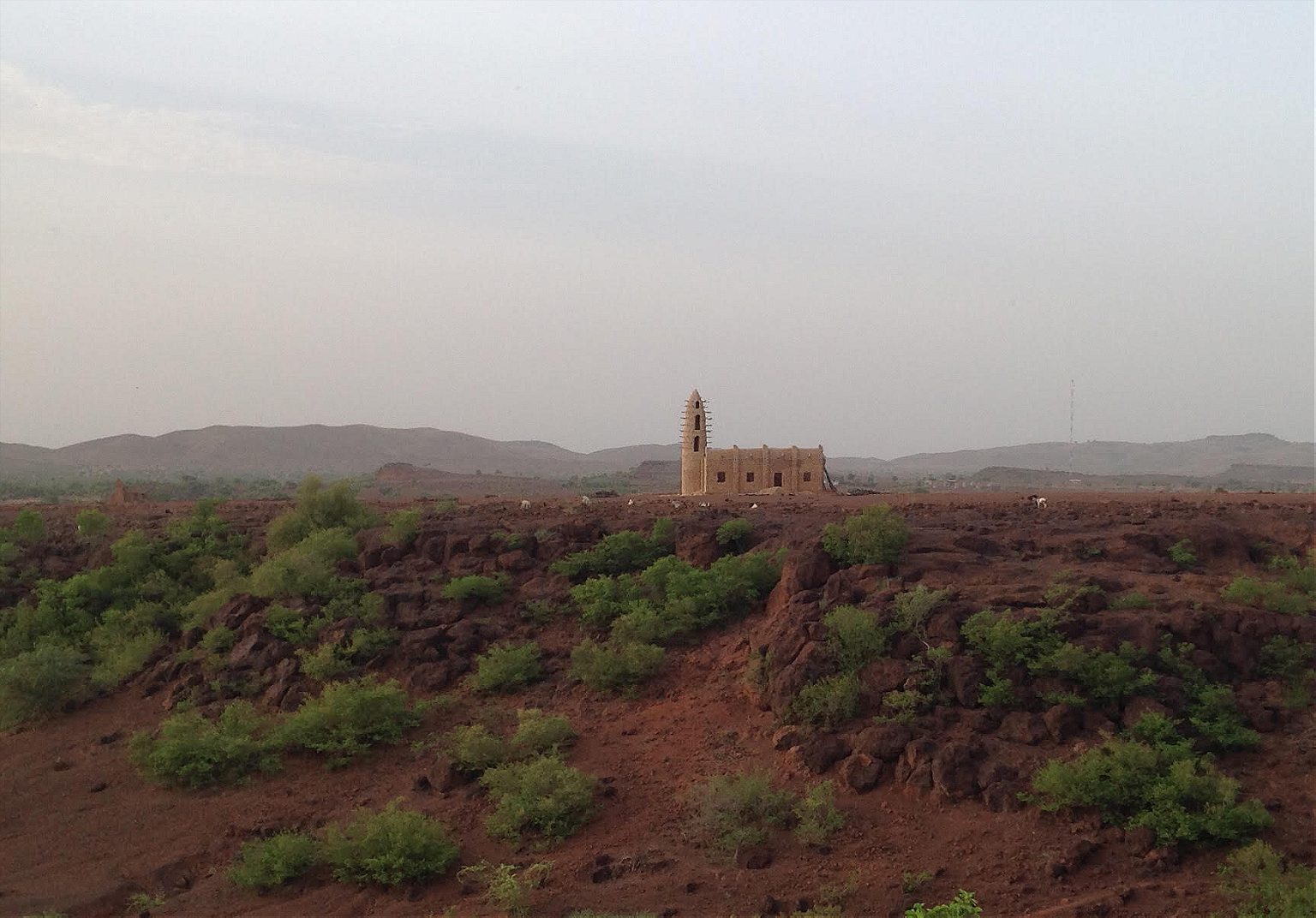In northern Burkina Faso, an eccentric spiritual leader’s unusual vision reflects the country’s unique approach to Islam.
The Prophet of Bani is often discussed but rarely seen. Bits of truth and rumor fill the void of his absence. His name is Mohamed el-Hajj and he is in his eighties. He is said to have made the pilgrimage to Mecca, on foot, all the way from Burkina Faso. No one has ever seen him eat or drink. He never learned to read or write, but recites passages of the Koran word-for-word to his followers.
Mohamed el-Hajj is a man of vision, the most grandiose of which came to fruition some thirty years ago, when he built seven mosques in his hometown on a shoestring budget. Six of the mosques were built at the top of Bani’s main hill. They are directed not toward Mecca, but instead face a larger mosque in the center. Erected in the early nineteen-eighties, the crumbling adobe mosques have prematurely weathered for lack of maintenance, making them look much older than they actually are.
In a country with little or no heritage sites, the controversial mosques put the small town of Bani on the map. On the road from Ouagadougou to the Nigerien border, about 15 miles before the yellow dunes of the Sahara, the town of 4,000 people is, on the surface, typical of settlements in northern Burkina Faso: scorching hot during the dry season, with few home-grown products other than cereals, such as pearl millet (petit mil) and sorghum. Its population is predominantly rural and Muslim. Since Islam arrived in sub-Saharan Africa via trade routes cutting through the Sahara from Morocco to Niger, it has dominated the north of Burkina Faso, particularly among the once-nomadic Fulani (also known as Peuls), and kel-Tamashek, a Berber people originally from North Africa. It is also the religion of the mostly urban Mossi, Burkina’s dominant ethnic group.

Burkina Faso’s approach to religion is unique. The factors commonly used to explain the country’s solid religious tolerance, such as the geographic diversity of religious and ethnic groups across the country, or the relative balance in numbers between the two main religious groups—Muslims and Christians—have led in other countries to long-lasting conflicts. In a region where religious-based violence is widespread and growing, this off-tempo trend explains why there was space at all in Bani for Mohamed el Hajj’s fanciful project.
Officially, Bani is now in the Red Zone: Because of its proximity to conflict zones in neighboring Mali and Niger, the flock of Ouagadougou-based weekend tourists has vanished. It is, however, a peaceful place untouched by terrorism, extremism, or regional epidemic. Hobbies include driving to the desert dam as well as drinking the odd beer on top of the hill at sunset, with choirs of toads singing in the background and the mosques quietly breaking the horizon.
Moussa and Noum joke about being lax Muslims
Although it is the second week of fasting during Ramadan, a handful of clients are sitting in the courtyard of Bani’s main restaurant, eating lunch. Moussa Ouedraogo and Noum Cisse are having riz gras, a popular rice dish served with meat sauce. “Except for civil servants, everybody in Bani is Muslim,” says Moussa, who grew up with Mohamed el Hajj’s grandchildren. When Moussa is not digging for gold in a nearby mine, like many young men of his generation, he co-runs the Campement Le Nomade, founded by Noum, Mohamed el Hajj’s direct grandson.
Both Moussa and Noum joke about being lax Muslims. “We don’t eat pork, but we sometimes drink alcohol,” Noum says. “Some go to the mosque and pray, some don’t. Some fast during Ramadan, some don’t. It’s really up to you.”

In Burkina Faso, most people would describe themselves as practicing Christians or devout Muslims. However, followers of both denominations practice in a way that doesn’t interfere with everyday public life. This is why, even though Bani is famous for the mosques, there is little visible evidence on the street of the town’s majority Muslim influence. Women don’t wear the veil. Young people drink water in public during fasting without concern. When a Wahhabi mosque opened in Bani a couple of years ago, the strict interpretation of Islam preached by the project’s Gulf-funded managers engendered suspicion in town.
“I don’t understand these people,” Noum tells me. “They’re asking us not to shake hands with girls we’ve been growing up next door to. They can’t tolerate that some young people like to drink beer on occasions. What does this all mean?”

After lunch, we visit the Grand Mosque. Even though it’s the beginning of the rainy season, the temperature is 39 degrees Celsius, and the mosque’s shelter provides a welcome reprieve. Set at the base of the hill, the main mosque was designed by Mohamed el Hajj himself. It is surrounded by six smaller mosques, laid out over the hill in the shape of a man kneeling for prayer. Noum draws the seven-mosque pattern in the sand, using a stick, to demonstrate how the peculiar shape of the hill matches the image of the man. “Here, you have the hands, here, the feet, and finally, here, the head,” he says. “Can you see it?” According to Noum, the number of mosques represents the days of the week.
Inside, bats fly high under the beamed ceiling, a group of dignified old men, dressed in flowing, traditional robes, quietly reads the Koran from massive, yellow-paged books. At the center of the group, lying on sheepskin mats and leading the reading, is Bani’s current imam, Mohamed el Hajj’s first son. His name is Ahmadou Hama. His manners are those of a stern teacher—he’s been in charge of Bani’s Koranic school for the past 30 years—and yet he readily welcomes me to the group and is happy to talk about his father’s unusual life.

“This is how it started,” the imam says in peul, Bani’s most commonly spoken language, while Noum, his nephew, translates into French. “When he was a small boy, my father was once sitting where I sit now with his own father and said: One day, the house of God will stand here. Then, the boy got up and disposed piles of rocks around them, forming a large square. His father, looking at the rocks, exclaimed: We’re not rich people, we can’t afford to build such a place. The boy replied simply: People will help us build it. Years passed and Mohamed was spending most of his time outside of Bani, in the brousse, preaching. At some point, he disappeared. Some in the village started to claim that he was deceased.”
Several months later, Mohamed was spotted in Mecca by Bani villagers who had gone to Saudi Arabia for the traditional pilgrimage. He told them he had traveled there by foot. When he finally returned to his hometown, he announced his intention to build seven mosques and managed to convince his fellow villagers that the project was achievable. The word spread in the region and people began to pour into Bani to help build the mosques. They stayed for days or weeks, making mud bricks or carrying tools uphill. Some came to the town several times to help.

Intrigued marabouts—Koranic scholars in West Africa—came from Mali, Niger, and all over Burkina Faso to meet with Mohamed el Hajj and follow his Koranic teachings. Many of them were convinced of the prophet because it appeared to them that Mohamed el Hajj had been directly in touch with Allah, and that Allah’s word needed to be fulfilled. In total, it took 18 months to build the main mosque, and a few months for each of the remaining six.
Mohamed’s fame, however, quickly became double-edged. Alarmed marabouts went to Dori, the capital of Sahel region, to complain to religious authorities of what appeared to them like an apostate initiative. Indeed, Mohamed encouraged Bani’s people to pray three times a day at odd hours, instead of the five daily traditional Islamic prayers, whose changing schedules based on moon cycles are strictly followed anywhere in the world by devout Muslims. His idea was that people needn’t pray so often to try to reach Paradise in the afterlife as much as they needed to be compassionate, generous, and forgiving in this life. Today, his followers continue to pray according to Mohamed el Hajj’s ritual.
Two years after becoming Bani’s imam, Mohamed el Hajj stepped down. Noum insists that his grandfather wasn’t pushed out. In Bani, he’s always been a trusted, popular figure. He was tired of the sermons, the collective prayers and everything that the imam job entails. He was looking forward to leading an isolated, spiritual life instead. Asked about this particular moment of his father’s life, Ahmadou answers: “You know the lives of the prophets, you know how it is. Jesus, Abraham… some people thought their actions were legitimate while others thought they were crazy.” One of the old men lying on the mats rises from the ground and says, “He dresses exactly like a prophet, with homemade robes only.”

After a silence, we thank the imam for his availability and walk towards the rear of the building. Inside, too, the mosque looks hundreds of years old. Narrow, dusty stairs go up to the roof. It’s mid-afternoon and the heat has all but receded. “Mohamed el Hajj lives right around the corner,” says Moussa. Does he take part in those reading sessions? Does he ever walk around? Why can’t we meet him? Does he really exist?
All direct questions regarding the life of Mohamed el Hajj are met with evasive answers. “Oh, he comes out, sometimes,” says Moussa. “He’s easy to find. I mean, everybody knows where he lives,” he adds, knowing that this doesn’t apply to foreign visitors who have been repeatedly told it would be rather tricky to arrange an interview with him. “Children even go and play inside his house, and he lets them,” Moussa continues.
The next morning at dawn, after a sleepless night, I return to the mosque. In the yard, a cow with noble horns is sleeping in the shade. The door is open again, but the place is empty. I walk around the building. Still no prophet.
On my way back, on a street now busy with people, a dashing old man dressed in a simple, spotless robe pauses a few feet away from me. For a second, he smiles in my direction, and then he turns and disappears into the crowd.